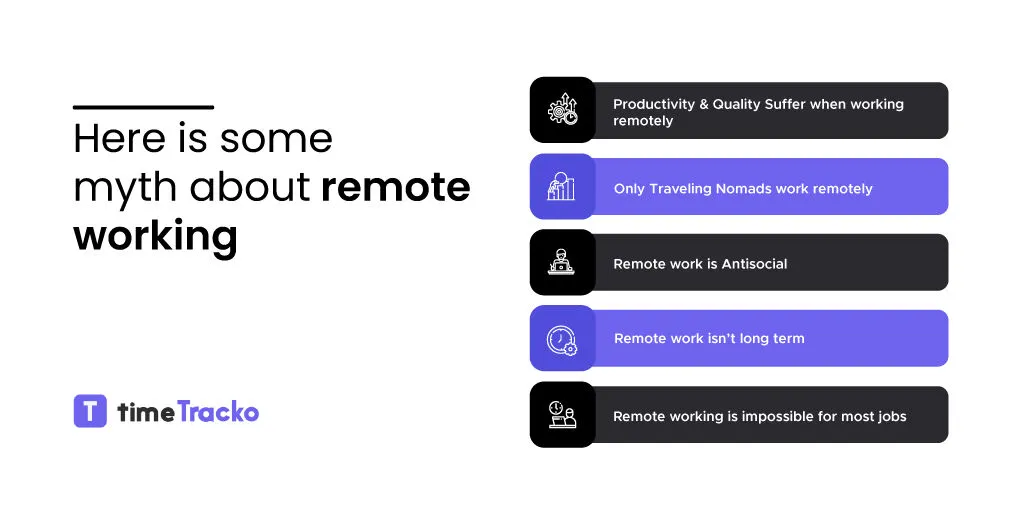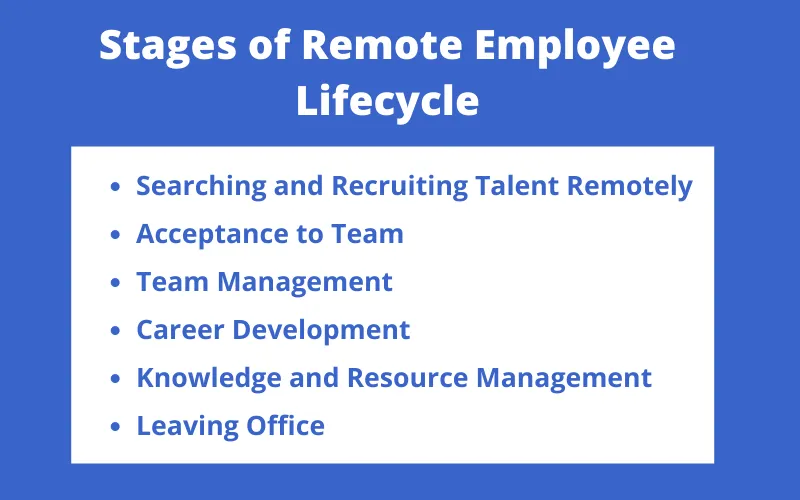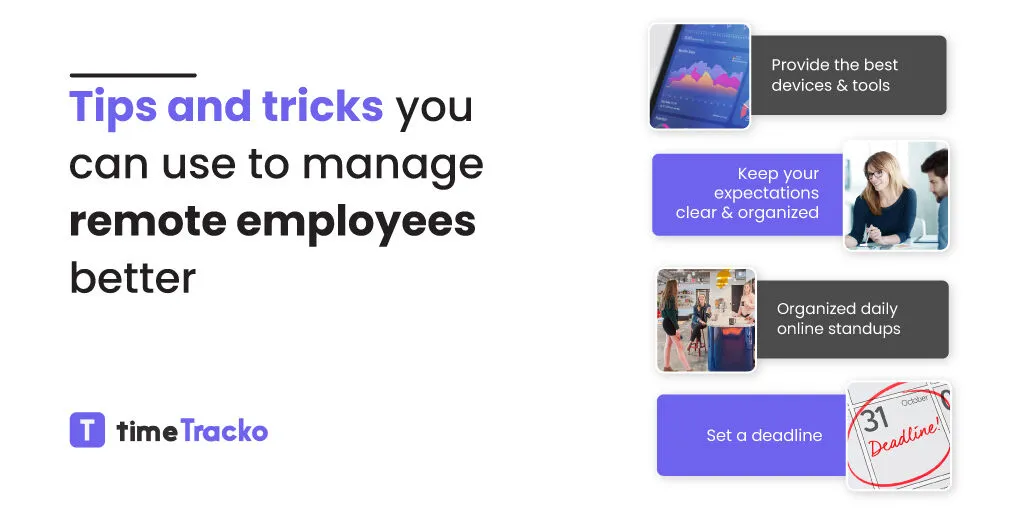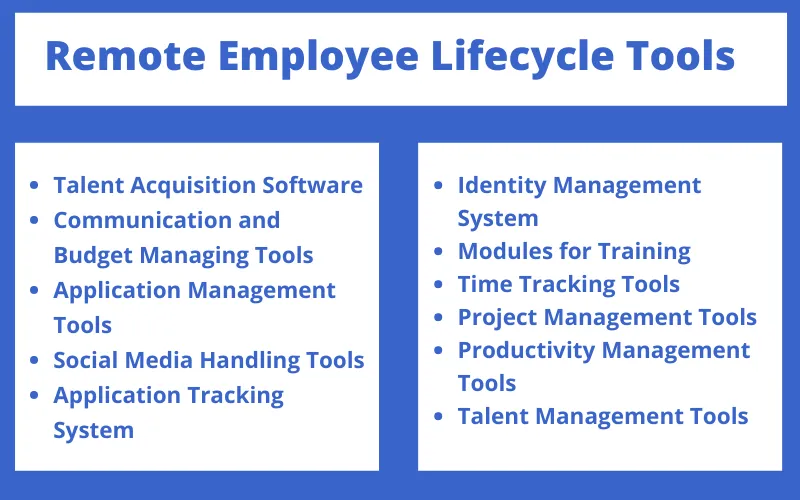Remote Employee Lifecycle
Remote Employee Lifecycle
Working remotely or hybrid work is the new trend changing the work from on-site offices to noticeable office functioning and processes alterations. Each employee working from home goes through their remote employee lifecycle.
It is essential to understand the remote employee lifecycle as it differs from normal.
In the remote lifecycle, the operation model of the office is different. So every step of the remote employee life cycle requires tools and software for maintaining and balancing the employee lifecycle from a distance.
Both employers and employees face challenges for the remote lifecycle of workers.
In remote work, the constant collaboration between employers and employees is mandatory for keeping the employees strong through the different stages of the employee lifecycle with the employee experience.
Remote Employee Lifecycle – Meaning
The remote employee lifecycle refers to the HR model that includes working remotely in an organization.
The remote employee lifecycle is the total time, resources, and energy spent working from a remote location until the end of their career in that office.
Another cycle can begin when a new employee is hired remotely. With the proper study of the remote employee lifecycle, the work providers can analyze different conclusions with HR strategy. An employee can learn from their remote work lifecycle for career advancement.

An employee can break their cycle by voluntarily leaving the job or due to some flaws in performance.
Another reason may be the diminishing of office or retirement of an employee to end the remote employee lifecycle.
Benefits of Remote Employee Lifecycle
Remote Employee Lifecycle is beneficial to both employers and employees. Normal employee lifecycle stages also include performance management, and employees expect total rewards.
Some benefits of remote employee lifecycle are mentioned below:
- When employers invest in the skills and training of their employees, the employees feel happy and give their best at work. The career of an employee is developed with better employee engagement.
- Employees feel cared for when employers give them honest reviews and recommendations throughout the cycle. Feedback from employers helps with employee wellbeing and employee wellness. You can conduct an engagement survey to know the situation of employees in the office.
- The retention of employees is possible when employees stay in the same office for a long time and give proper outputs. The human resource crisis decreases, and HR leaders can work easily with HR experts. Employees work passionately and collaborate well in a team with knowledge management and risk management.
- In the hiring process involving leaders, talented individuals are recruited when employers explain the work properly and have clear goals and objectives, adding more value to human resources in the information technology field.
Stages of Remote Employee Lifecycle

The remote employee lifecycle consists of seven stages from beginning to end. At each stage, the professional life of an employee changes. The different stages have their importance and are mentioned in the description below:
1. Searching and Recruiting Talent Remotely
The search for remote talent is not new in remote offices and global teams. Many talented people are waiting to get jobs involved in the war for talent, for which companies need to post vacancy openings with the job title on different sites and portals.
When hiring new employees, includes the side of both interested candidates seeking employee experience and employers in recruiting new talent.
With many people applying for a post, employers may find it difficult to choose the right ones. The world-class digital exchange is required for handling offices remotely.
Some points to remember while hiring people by HR leaders are:
Look for Capabilities
The recruiters need to look for skills and capabilities with previous experience of world-class digital involvement. When the candidate has previous experience, they can perform better for your company.
Hiring newbies give the office a chance to groom and produce able employees that give their best for the job and help in team building by solving the problems that arise in the team.
Body Language
The remote interview sessions demand face-to-face communication between the interview giver and taker for proper body language and facial expression in the war for talent.
The behavior of the interview giver is clear with soft skills and way of presentation and answerability. You can see the seriousness in the voice during the interview and mark the criteria accordingly.
Company Profile
Attracting many people demands a strong company profile with a workforce manager from the company’s side.
When you present the company as a good one and put necessary information like success stories to read, good people apply for the open positions.
Social media handles and job portals with websites like Linkedin are beneficial for making a company profile strong. Social media is also necessary for product marketing and attracting top talent.
Trust and Legal Issues
When hiring employees, ensure you take proper information and store information regarding the location and address.
When you hire employees remotely, there are issues of trust as they cannot visit you in person.
Remember to check the legal history of the employee to ensure safety and get the legal papers regarding the office ready if it is the first time you are taking an interview, watch the demo of the previous interview, and exit the interview in a sweet tone.
2. Acceptance to Team
For remotely hired employees, make sure to welcome the new members and appreciate the top talent with diversity equity.
Proper flow of communication is important for recent employees, and they need support from the employer’s side. Some ways to onboard members of your remote team are:
Clear Objectives and Goals
After accepting a new member, make sure you deliver the roles and responsibilities to the employee after you exit the interview. The team member can work efficiently with a clear undertaking of work objectives.
Rules and Regulations
It is very important to explain the team members’ remote rules, regulations, and policies in the digital age. Ensure they fit into the organizational culture and adapt to the remote work environment within the HR strategy.
You can explain the leave policy, the total breaks in a day and holidays, and an employee policy directed by the federal government for financial institutions.
Employee Engagement
When you are nice to the new employee, they are engaged and perform their best for the job title.
Employees remain passionate about work throughout the employee lifecycle stages when they receive enough encouragement and motivation for better work. The engagement survey gives positive results for HR strategy.
Benefits and Rewards
For employee wellbeing, it is important to give them rewards and praises for good work, so they continue good work. When something is missing, honest feedback and advice help the employees.
3. Team Management
Remote team management requires a flexible mindset and proper planning as many distractions occur in remote work.

Managing teams remotely is difficult, and below are some ways to manage the team properly:
Work-Life Balance
Employees have a hard time balancing work at home. Working at home demands more focus and concentration, and distractions may lead the users to lose focus on daily tasks during work time.
Working from home requires the perfect balance of personal and work life. It is also advised to go for trips and outings on the weekends because staying in the same place, and working is monotonous.
Technical Difficulties
Due to technical difficulties like the internet or tools and software not working appropriately, users may have difficulty working with team members.
As a solution, the other team members can help the one in trouble. A support system from the office is also mandatory.
4. Career Development
Online training with seminars and virtual programs is necessary for career development and investor relations.
The overall development of an employee career requires positivity and hard work with work dedication and enthusiasm. Some ways to enhance career development are:
Patience and Dedication
Developing an employee’s career demands a level of dedication and patience from the seeker to make their own success stories.
Skill development is a long process, and if employees stop with the same level of enthusiasm at a point, they may get diverted to go away from understanding and to gain knowledge.
Continuous Learning
The learning process extends from the beginning of the employee cycle to the end, and the employee should continue this at every step.
An employee should not find learning monotonous and boring in the digital age.
5. Knowledge and Resource Management
The way of conducting work or different work processes requires management and knowledge from each employee’s side.
There are fewer chances of knowledge exchange in virtual meetings and conversations, highlighting the growing need for effective knowledge management, especially when using cloud call center software, where teams often collaborate remotely and rely heavily on centralized information.
Some employees may have more access to data and resources than others, and sometimes technological difficulties make resource sharing difficult.
The office should keep them safe and secure from hacks and cyberattacks with much data and information.
Information distribution should remain even, and each employee should get the piece of information required.
6. Leaving Office
Leaving is the last stage of the remote employee lifecycle, mainly due to office dissolving, employee quitting, or retirement.
For any member leaving the organization, it is important to organize a virtual farewell retirement party.
For employees who leave on purpose, wishing them good luck for the future is admirable after the end of the remote employee lifecycle. The first hiring stage begins with another remote employee lifecycle beginning.
Remote Employee Lifecycle Tools

We are now aware of the different stages of the remote employee lifecycle. It’s time to know how the tools and software aid in every step of the remote employee lifecycle.
Tracking tools with management software are essential to handle the remote employee lifecycle properly and maintain each employee.
The stages are handled easily in a normal employee lifecycle, but extra work is necessary for each step in remote work. The roles of tools in remote employee lifecycle for your office are given below:
1. Hiring Phase
The hiring of employees is the beginning of the remote employee life cycle. When you recruit a new employee, the following tools act as options to help in simplifying the hiring process.
Talent Acquisition Software
Talent acquisition software helps in the overall hiring process, from sourcing to screening the employees. The interview taking is also easy with the onboarding of employees.
Communication and Budget Managing Tools
Communication tools are important for holding interviews. Video conferencing helps in face-to-face interviews and interacting with new office members.
Budget management tools help with cost savings in the offices.
Application Management Tools
Application management tools help manage the different applications that your office uses. The network of different apps and software for remote work requires intranet and email sending, and application management software deals with the clients and servers in office locations.
Social Media Handling Tools
These tools are necessary for branding your remote office and posting job vacancies for finding the capable personnel for the perfect jobs by letting more people view the job vacancy with digital experience.
Application Tracking System
The system helps HR speed up the hiring process by analyzing the different applications and resumes received for a particular work vacancy.
2. Onboarding Phase
The onboarding phase includes accepting jobs, intaking new employees officially as company members, and aiming for employee retention.
You may use different tools to make the onboarding phase easy. Some tools and software are given below:
Identity Management System
Access and identity management systems are necessary to collect information from new employees and keep personal data safe in the contact center.
The task assignment with roles and accessing of the data by employees is possible.
Modules for Training
New employees must have strategic planning to design and implement modules. Employees can learn new skills and receive training. The tracking of productivity requires productivity trackers.
3. Development Phase
The development phase is when employees require feedback from employers. You need help from different tools that track employee productivity and time for giving advice and honest reviews. Some tools and software needed in the development phase are:
Time Tracking Tools
Time tracking tools track every employee’s time, and employers can assign deadlines for project completion. You can know the productive and non-productive hours of employees.
Project Management Tools
Project management tools make work easy for project managers by strategic planning and assigning duties to product marketing. Task scheduling is easier with task management apps.
Productivity Management Tools
Productivity management tools measure the workflow and productivity of employees. These tools help in decreasing presenteeism and absenteeism in employees.
4. Retaining Phase
The retaining of employees is possible when there is employment development. Talent management software is necessary for the retaining phase to manage employees’ talent. Talent management applications help in the overall remote employee cycle.
Conclusion
The remote employee lifecycle is no less than the organism’s life cycle in life sciences. The different stages aim for employee retention through human resources management and employee experience.
The personal data in different office locations need security with the proper digital experience of workers.

 in Melbourne
in Melbourne 
 Employee Screen Monitoring Software
Employee Screen Monitoring Software App and Website Monitoring Software
App and Website Monitoring Software Time and Attendance Software
Time and Attendance Software Finance
Finance Banking
Banking Healthcare
Healthcare Lawyers
Lawyers Retail & ecommerce
Retail & ecommerce Knowledge base
Knowledge base Blogs
Blogs Installation Guide
Installation Guide FAQs
FAQs About
About Media Kit
Media Kit Contact us
Contact us